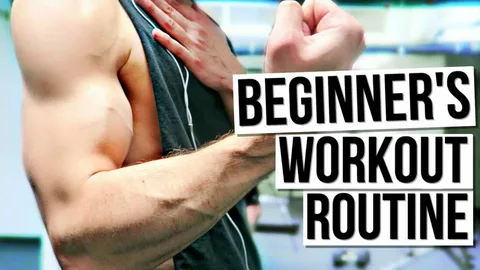Introduction: Why Every Beginner Needs a Smart Gym Plan
Starting your fitness journey can feel intimidating, especially when you step into a gym filled with complex machines and experienced lifters. But the truth is, every fitness expert once started as a beginner — what made them successful was following a structured, sustainable plan.
A beginner gym routine helps you build strength, endurance, and confidence while preventing injuries and burnout. It’s not about lifting the heaviest weights or spending hours in the gym; it’s about learning proper technique, staying consistent, and making gradual progress.
If you’re new to the gym and want a clear guide to get started the right way, this blog will help you design a simple yet effective workout routine that delivers real results.
1. Understand Your Fitness Goals
Before creating a gym routine, define your primary goal. Your approach will differ depending on whether you want to:
-
Lose fat and tone up
-
Build lean muscle
-
Improve endurance and stamina
-
Enhance overall fitness and strength
Clear goals guide your training style, exercise selection, and nutrition. For instance, if your focus is muscle growth, you’ll use moderate weights with progressive overload. If it’s fat loss, you’ll combine strength training with more cardio sessions.
Take time to write down your goals — it keeps you motivated and accountable as you progress.
2. Learn the Basics of a Balanced Workout
A well-rounded gym routine includes four main components:
-
Warm-up: Prepares your body for movement and prevents injury.
-
Strength training: Builds muscle and boosts metabolism.
-
Cardio training: Improves heart health and endurance.
-
Cool-down and stretching: Helps recovery and flexibility.
Balancing these elements ensures steady progress without overtraining or burnout. Beginners should focus on full-body workouts three days a week, giving muscles time to recover between sessions.
3. Start with Full-Body Workouts
For beginners, full-body workouts are more effective than targeting specific muscle groups. They help you develop overall strength and teach proper movement patterns.
Here’s a sample 3-day beginner routine:
Day 1 – Full Body Strength
-
Squats – 3 sets of 10 reps
-
Push-ups (or machine press) – 3 sets of 8–10 reps
-
Lat pulldown – 3 sets of 10 reps
-
Dumbbell shoulder press – 3 sets of 12 reps
-
Plank – 3 rounds of 30 seconds
Day 2 – Cardio and Core
-
20–30 minutes treadmill walking or cycling
-
Leg raises – 3 sets of 12 reps
-
Russian twists – 3 sets of 15 reps per side
Day 3 – Full Body with Focus on Form
-
Deadlifts (light weights) – 3 sets of 8 reps
-
Lunges – 3 sets of 10 reps per leg
-
Seated rows – 3 sets of 10 reps
-
Bicep curls – 3 sets of 12 reps
-
Side plank – 3 rounds per side
Stick to this routine for the first 4–6 weeks, focusing on technique and consistency before increasing weight or intensity.
4. Focus on Proper Form and Technique
One of the most common mistakes beginners make is lifting too heavy too soon. This not only reduces results but can also cause serious injuries.
Always prioritize form over weight. Learn proper technique for each movement — watch tutorials, ask trainers for guidance, or record yourself to check alignment.
Key points to remember:
-
Keep your back straight during lifts.
-
Engage your core for stability.
-
Move slowly and with control.
-
Avoid locking your joints at the end of a movement.
When you move correctly, you’ll build strength faster and safely.
5. Add Cardio for Better Endurance
Cardio exercises like running, cycling, or rowing improve heart health, burn calories, and support recovery. Beginners should start with low to moderate intensity for 20–30 minutes, 3–4 times a week.
If your goal is fat loss, combine strength training with cardio intervals such as:
-
1 minute sprint + 2 minutes walk (repeat for 20 minutes)
-
10-minute rowing intervals
-
Stair climber for endurance building
As your stamina improves, gradually increase duration and intensity.
6. Include Rest and Recovery
Muscles don’t grow in the gym — they grow during rest. Recovery allows your body to repair tissue, balance hormones, and rebuild stronger muscles.
Here’s how to recover effectively:
-
Sleep 7–8 hours per night.
-
Take at least one rest day between gym sessions.
-
Stretch after every workout to reduce soreness.
-
Stay hydrated and eat nutrient-dense foods.
If you feel fatigued or sore for several days, it’s a sign your body needs extra rest. Listen to it — rest is part of progress.
7. Track Your Progress
Tracking your progress helps you stay motivated and make adjustments. Keep a simple workout log noting:
-
Exercises and weights used
-
Number of reps and sets
-
How you felt during each workout
You can also take weekly photos or measurements to see visible changes. Even small improvements — like an extra rep or lifting slightly more weight — show that your plan is working.
8. Fuel Your Body with Proper Nutrition
Training hard without eating right limits your results. Your body needs fuel for workouts and nutrients for recovery.
For muscle gain, eat slightly above your calorie maintenance with plenty of protein.
For fat loss, reduce your intake slightly while maintaining enough protein to preserve muscle.
Simple nutrition tips for beginners:
-
Eat protein-rich foods like eggs, chicken, tofu, and lentils.
-
Include complex carbs such as brown rice, oats, and fruits.
-
Don’t skip healthy fats like nuts, olive oil, and avocado.
-
Stay hydrated throughout the day.
A balanced diet supports consistent energy levels and faster recovery.
9. Stay Consistent and Be Patient
Building fitness takes time. The biggest mistake beginners make is expecting quick results. Your body will change — but only through consistency, discipline, and patience.
Start small and aim for steady progress rather than perfection. Celebrate small wins, such as lifting heavier weights or feeling more energetic. Over time, these habits form the foundation of lasting health and fitness.
A Smarter Way to Build Your Gym Journey
Creating the perfect beginner gym routine isn’t about intensity; it’s about sustainability. When you focus on proper technique, gradual improvement, and consistent effort, your workouts become enjoyable and rewarding. With the right balance of strength, cardio, and recovery, you’ll see steady growth — both physically and mentally — turning your gym time into a lifelong habit of health and strength.







